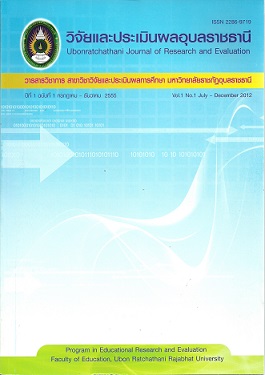การพัฒนารูปแบบการนิเทศการฝึกประสบการณ์วิชาชีพครูตามหลักสูตรครุศาสตรบัณฑิต มหาวิทยาลัยราชภัฏ 155-165
คำสำคัญ:
: การพัฒนา รูปแบบการนิเทศการฝึกประสบการณ์วิชาชีพครู หลักสูตรครุศาสตรบัณฑิตบทคัดย่อ
การวิจัยครั้งนี้ มีวัตถุประสงค์เพื่อพัฒนารูปแบบการนิเทศการฝึกประสบการณ์วิชาชีพครู ตามหลักสูตร ครุศาสตรบัณฑิต มหาวิทยาลัยราชภัฏ และศึกษาผลการใช้รูปแบบการนิเทศการฝึกประสบการณ์วิชาชีพครู ตามหลักสูตรครุศาสตรบัณฑิต มหาวิทยาลัยราชภัฏ การดำเนินการวิจัย แบ่งออกเป็น 2 ขั้นตอน คือ ขั้นตอนที่ 1 พัฒนารูปแบบการนิเทศการฝึกประสบการณ์วิชาชีพครู ตามหลักสูตรครุศาสตรบัณฑิต มหาวิทยาลัยราชภัฏ และขั้นตอนที่ 2 ศึกษาผลการใช้รูปแบบการนิเทศการฝึกประสบการณ์วิชาชีพครู ตามหลักสูตร ครุศาสตรบัณฑิต มหาวิทยาลัยราชภัฏ ประชากรและกลุ่มตัวอย่างที่ใช้ในการวิจัยในครั้งนี้ ได้แก่ 1) ประชากร ที่ใช้ในการสังเคราะห์องค์ประกอบ ตัวบ่งชี้ ตัวบ่งชี้ย่อยและแนวปฏิบัติที่นำไปสู่ตัวบ่งชี้ย่อยของรูปแบบฯ โดยศึกษาจากเอกสารทั้งหมด คือ 1.1) คู่มือและเอกสารในการนิเทศการฝึกประสบการณ์วิชาชีพครูของมหาวิทยาลัย ราชภัฏ 38 แห่ง รวม 73 เล่ม และ1.2) เอกสารและงานวิจัยที่เกี่ยวข้องอื่นๆ รวม 74 เล่ม 2) ประชากร ที่ใช้ในการตรวจสอบรูปแบบการนิเทศฯ คือ บุคลากรที่เกี่ยวข้องกับการนิเทศการฝึกประสบการณ์วิชาชีพครู ในมหาวิทยาลัยราชภัฏ 38 แห่ง โดยเลือกกลุ่มตัวอย่างที่ใช้ในการตรวจสอบรูปแบบฯ คือ 2.1) คณะกรรมการฝึกประสบการณ์วิชาชีพครู 2.2) อาจารย์นิเทศก์ 2.3) ครูพี่เลี้ยง และ2.4) ผู้บริหารสถานศึกษา ในมหาวิทยาลัยราชภัฏ 4 แห่งในแต่ละภาค รวม 4 ภาค จำนวน 88 คน 3) กลุ่มตัวอย่างสำหรับใช้ในการตรวจสอบ หาคุณภาพของเครื่องมือนิเทศและประเมินผล ในองค์ประกอบที่ 5 เครื่องมือนิเทศและประเมินผลของรูปแบบการนิเทศฯ ได้แก่ อาจารย์นิเทศก์ ครูพี่เลี้ยง ผู้บริหารสถานศึกษาและนักศึกษา มหาวิทยาลัยราชภัฏศรีสะเกษ รวม 111 คน 4) ประชากร ที่ใช้ในการศึกษาผลการใช้รูปแบบฯ ได้แก่ คณะกรรมการฝึกประสบการณ์วิชาชีพครู อาจารย์นิเทศก์ ครูพี่เลี้ยง ผู้บริหารสถานศึกษาและนักศึกษาคณะครุศาสตร์ มหาวิทยาลัยราชภัฏอุบลราชธานี รวม 500 คน ซึ่งผู้วิจัยใช้เป็นกลุ่มตัวอย่างในการศึกษาการวิจัยในครั้งนี้
ผลการวิจัยพบว่า
- ผลการพัฒนารูปแบบการนิเทศการฝึกประสบการณ์วิชาชีพครู ตามหลักสูตรครุศาสตรบัณฑิต มหาวิทยาลัยราชภัฏ พบว่า
1.1 รูปแบบการนิเทศการฝึกประสบการณ์วิชาชีพครู ตามหลักสูตรครุศาสตรบัณฑิต มหาวิทยาลัยราชภัฏ ประกอบด้วย 5 องค์ประกอบ 19 ตัวบ่งชี้ 58 ตัวบ่งชี้ย่อย 255 แนวปฏิบัติที่เป็นวิธีการ ขั้นตอน เพื่อให้บรรลุผลสู่ตัวบ่งชี้ย่อย
1.2 ผลการตรวจสอบรูปแบบการนิเทศการฝึกประสบการณ์วิชาชีพครูฯ โดยภาพรวมทั้ง 5 องค์ประกอบของรูปแบบการนิเทศฯ ด้านการนำไปใช้ได้จริง เป็นวิธีการ ขั้นตอนต่างๆ ที่สามารถนำไปสู่การปฏิบัติได้จริง และด้านประโยชน์ที่ได้รับ เป็นผลการดำเนินงานตามวิธีการ ขั้นตอนต่างๆ ที่ส่งผลให้นักศึกษาได้เกิดการเรียนรู้ในการฝึกประสบการณ์วิชาชีพครู โดยมีผลการตรวจสอบด้านการนำไปใช้ได้จริงและด้านประโยชน์ ที่ได้รับอยู่ในระดับมากที่สุด ทั้ง 2 ด้าน และทุกรายการตรวจสอบสามารถนำไปใช้ในการดำเนินงานตามรูปแบบการนิเทศการฝึกประสบการณ์วิชาชีพครูได้
1.3 ผลการตรวจสอบหาคุณภาพของเครื่องมือนิเทศและประเมินผล ในองค์ประกอบที่ 5 เครื่องมือนิเทศและประเมินผลของรูปแบบการนิเทศการฝึกประสบการณ์วิชาชีพครูฯ พบว่า ชุดที่ 1 แบบบันทึกการนิเทศ การปฏิบัติการสอนในสถานศึกษา สำหรับนักศึกษา พบว่า นักศึกษาทุกคนสามารถบันทึกข้อมูลการนิเทศตาม คำชี้แจงได้อย่างถูกต้อง ชุดที่ 2 แบบนิเทศและประเมินผลพฤติกรรมการปฏิบัติการสอนในชั้นเรียน สำหรับอาจารย์นิเทศก์ ครูพี่เลี้ยง พบว่า มีค่าดัชนีความสอดคล้องของผู้ประเมิน (RAI) ทั้งฉบับเท่ากับ .9120 ชุดที่ 3 แบบนิเทศและประเมินผลคุณลักษณะความเป็นครูและการปฏิบัติตน สำหรับอาจารย์นิเทศก์ ครูพี่เลี้ยง และผู้บริหารฯ พบว่า มีค่าดัชนีความสอดคล้องของผู้ประเมิน (RAI) ทั้งฉบับเท่ากับ .9151 และชุดที่ 4 แบบประเมินผลการปฏิบัติงานนอกชั้นเรียน สำหรับ ครูพี่เลี้ยง พบว่า นักศึกษาสามารถบันทึกงานต่างๆ ที่ได้รับมอบหมายจากสถานศึกษาตามคำชี้แจงได้อย่างถูกต้อง และ ครูพี่เลี้ยงสามารถตรวจให้คะแนนผลการปฏิบัติงานนอกชั้นเรียนของนักศึกษาตามเกณฑ์รูบริคส์ ได้อย่างถูกต้อง
- ผลการใช้รูปแบบการนิเทศการฝึกประสบการณ์วิชาชีพครู ตามหลักสูตรครุศาสตรบัณฑิต มหาวิทยาลัยราชภัฏ พบว่า
2.1 ผลการประเมินการใช้รูปแบบการนิเทศฯ ทั้ง 5 องค์ประกอบ ได้แก่ 1) ด้านการบริหารจัดการ 2) ด้านบุคลากรที่เกี่ยวข้องการนิเทศการฝึกประสบการณ์วิชาชีพครูฯ 3) ด้านเนื้อหาการนิเทศ 4) ด้านกระบวนการ นิเทศ และ5) ด้านเครื่องมือนิเทศและประเมินผล พบว่า มีผลการประเมินในด้านความเหมาะสมกับสภาพจริง ด้าน ความเหมาะสมกับวัตถุประสงค์ของการฝึกประสบการณ์วิชาชีพครู และด้านประโยชน์ที่ได้รับ โดยรวม ทั้ง 3 ด้าน ในระดับมากถึงมากที่สุด
2.2 ผลการตรวจสอบความเที่ยงตรงของคะแนนประเมินผลการปฏิบัติการสอนในสถานศึกษา พบว่า 1) ผลการตรวจสอบความสอดคล้องของการให้คะแนนของผู้ประเมิน 1.1) ด้านพฤติกรรมการปฏิบัติการสอน ในชั้นเรียน ระหว่างอาจารย์นิเทศก์กับครูพี่เลี้ยง ให้คะแนนการประเมินมีความสอดคล้องสัมพันธ์กันทางบวกมีค่าสัมประสิทธิ์สหสัมพันธ์สเปียร์แมน (Spearman Rank Correlation Coefficient) เท่ากับ .4432 อย่างมีนัยสำคัญทางสถิติที่ระดับ .01 1.2) ด้านคุณลักษณะความเป็นครูและการปฏิบัติตน ระหว่างอาจารย์นิเทศก์ ครูพี่เลี้ยง และผู้บริหารสถานศึกษา ให้คะแนนการประเมินมีความสอดคล้องสัมพันธ์กันทางบวกมีค่าสัมประสิทธิ์สหสัมพันธ์เคนดอล (Kendall Rank Correlation Coefficient) เท่ากับ .1717 อย่างมีนัยสำคัญทางสถิติที่ระดับ .01 2) ผลการตรวจสอบ ความสัมพันธ์ของระดับคะแนนการปฏิบัติการสอนในสถานศึกษาของนักศึกษากับระดับคะแนนเฉลี่ยกลุ่มวิชาชีพครูของนักศึกษา (มาตรฐานความรู้และประสบการณ์วิชาชีพครู) พบว่า มีความสัมพันธ์กันทางบวกโดยมีค่าสัมประสิทธิ์ คอนติงเจนซี (The Coefficient of Contingency) เท่ากับ .2561 อย่างมีนัยสำคัญทางสถิติที่ระดับ .01
เอกสารอ้างอิง
คณะทำงานวิจัยและพัฒนาหลักสูตรการฝึกหัดครูแนวใหม่ สำนักงานสภาสถาบันราชภัฏ, สำนักพัฒนาการฝึกหัดครู (2543). แนวทางการพัฒนาหลักสูตรการฝึกหัดครูของสถาบันราชภัฏ. กรุงเทพฯ: สำนักงานสภาสถาบันราชภัฏ คณะทำงานวิจัยและพัฒนาหลักสูตรการฝึกหัดครูแนวใหม่.
ไพฑูรย์ สินลารัตน์ . (2555). หลักและเทคนิคการสอน ระดับอุดมศึกษา. พิมพ์ครั้งที่ 3. กรุงเทพฯ: โรงพิมพ์แห่งจุฬาลงกรณ์มหาวิทยาลัย .
ไพฑูรย์ สินลารัตน์ และคณะ. (2554). กรอบมาตรฐานคุณวุฒิระดับอุดมศึกษาของประเทศไทย : จากการวิจัยสู่การปฏิบัติ. พิมพ์ครั้งที่ 3. กรุงเทพฯ: โรงพิมพ์แห่งจุฬาลงกรณ์มหาวิทยาลัย.
ยนต์ ชุ่มจิต. (2550). ความเป็นครู. พิมพ์ครั้งที่ 4. กรุงเทพฯ: โอเดียนสโตร์ .
ราตรี นันทสุคนธ์. (2547). การพัฒนารูปแบบการประเมินแบบร่วมมือสำหรับประเมินการฝึกประสบการณ์วิชาชีพครูของสถาบันราชภัฏ. ปริญญาการศึกษาดุษฎีบัณฑิต สาขาวิชาวิจัยและประเมินผลการศึกษา มหาวิทยาลัยนเรศวร.
วิชัย ตันศิริ. (2547). โฉมหน้าการศึกษาไทยในอนาคต แนวคิดสำคัญของการปฏิรูปในพระราชบัญญัติการศึกษา. พิมพ์ครั้งที่ 4. กรุงเทพฯ: โรงพิมพ์แห่งจุฬาลงกรณ์มหาวิทยาลัย .
สำนักงานเลขาธิการคุรุสภา, สำนักมาตรฐานวิชาชีพ. (2548). มาตรฐานวิชาชีพทางการศึกษา. กรุงเทพฯ: สำนักงานเลขาธิการคุรุสภา.
ดาวน์โหลด
เผยแพร่แล้ว
รูปแบบการอ้างอิง
ฉบับ
ประเภทบทความ
สัญญาอนุญาต
1. บทความที่ตีพิมพ์ในวารสารนี้ได้มีการตรวจสอบการลอกเลียนงานวรรณกรรมแล้ว ไม่เกินร้อยละ 25
2. บทความที่ตีพิมพ์ในวารสารนี้เป็นข้อคิดเห็น ข้อค้นพบของผู้เขียนบทความ โดยผู้เขียนบทความต้องเป็นผู้รับผิดชอบต่อผลทางกฎหมายใด ๆ ที่อาจเกิดขึ้นจากบทความนั้น ๆ
3. บทความ ข้อมูล เนื้อหา รูปภาพ ฯลฯ ที่ได้รับการตีพิมพ์ในวารสารวิจัยและประเมินผลอุบลราชธานี ถือเป็นลิขสิทธิ์ของวารสารวิจัยและประเมินผลอุบลราชธานี หากบุคคลหรือหน่วยงานใดต้องการนำทั้งหมดไปเผยแพร่ต่อหรือเพื่อกระทำการใดๆ จะต้องได้รับอนุญาตเป็นลายลักษณ์อักษรจากวารสารวิจัยและประเมินผลอุบลราชธานีก่อนเท่านั้น และจะต้องมีการอ้างอิงวารสารวิจัยและประเมินผลอุบลราชธานี ฉบับนั้น ๆ ด้วย






